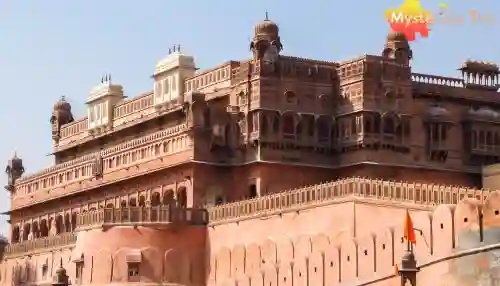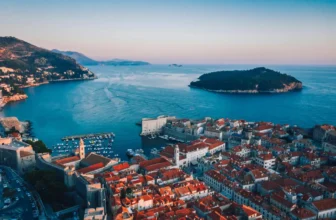
The eye of the Sahara would be the most mysterious thing on earth. Located in an isolated area of the Sahara desert in Mauritania, The Eye of Sahara, known as the ‘Richat Structure, ‘is slightly oval and deeply eroded in the Sahara desert. It is instead a vast circular formation.
Initially, it was assumed to be a hole in the surface. Still, the astronauts’ recent photographs sent from space suggested that it is not a crater but a result of erosion that happened in geological time. You won’t notice much of it if you’re walking by it.
What formed the Richat Structure?/What caused the Richat Structure?
When a volcano’s hardened dome slowly wore away, it revealed layers of rock resembling the layers of an onion.
The size of this place (Sahara, Mauritania) is 40km wide. The eye of the Sahara Atlantis was so big but not discovered until the astronauts saw it from space.
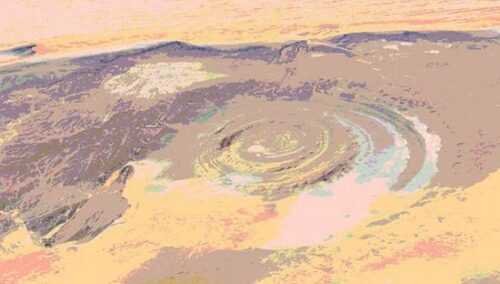
People also called the Sahara’s eye by the name ‘blue eye’ of Africa because, in some of the images taken by NASA, the structure looked blue.
So far, no one has figured out why these concentric rings formed in the middle of the desert.
Some theorized that it formed an asteroid strike since the formation is circular and not too oval. Still, this theory has been ridiculed and suggested that the reason behind the Richat formation is a volcanic eruption.
This theory doesn’t appear believable since there is no proof of volcanic rock in that area.
Another perspective is that the concentric rings of the Eye of Sahara are of equal distance from the core that might be symmetrical because it was human-made.
Many people still think that the eye of the Sahara is the doomed city of Atlantis. Though, Plato’s description of Atlantis does give an exact impression of the formation of the Richat Structure Mauritania.
Was the Richat Structure Atlantis?
The lost city of Atlantis.
Plato described Atlantis as a round divided into circles of land and water. When an earthquake hit Atlantis, it became impossible for the voyagers to sail because the mud prevented any movement, making it harder for sailors to cross the city from any part of the ocean.
Atlantis, in Greek, stands for the island of Atlas. Plato also said Atlantis lay in ’front of the pillars of Hercules.’

However, it is unlikely to think of it as the city of Atlantis, but if we look into it like Plato’s description, it still is an exciting way to look into this theory.
There’s so much to learn, but due to this place’s inaccessibility and lack of research, this place hasn’t been given much attention.
Hopefully, in the future, we’d get access to this place and find the answer regarding the reason for forming the eye of the Sahara.
The Future of the Eye
The eye of the Sahara lures both geologists and tourists. Several geologists fly to the Richat structure to personally research the distinct geological aspect.
Yet, because water is scarce and the Sahara’s eye is situated in a sparsely populated area, it is at risk from human activity.
That leaves the structure open to much threat of nature. The current land erosion is developing a massive threat to the landscape. Chances are there would be desert winds in the region due to climate change triggering desertification.

The Sahara’s eye would likely be swamped with dust & sand in the near future. Travelers in the future might discover this stunning geological aspect buried in the desert.
Traces of Pangaea
The primitive rocks in the eye of the Sahara have proffered investigators data about its foundation. The earliest creation of the Richat structure started when the supercontinent Pangaea began to rupture.
Right after Pangaea burst, the water from the Atlantic Ocean began flowing into the region.
Even though Pangaea was gradually bursting, magma from the surface of its depth started emerging from the earth’s mantle, which developed a round-shaped rocky roof encompassed by sandstone deposits.
As erosion began dispersing on the igneous rocks and sandstones, and when the dome diminished, round edges were left behind, passing the structure’s eye’s hollow circular shape. Currently, the eye is slightly sunken under the level of the close site.
According to scientists, the eye could have developed roughly 100 years ago. It is presumed that the Richat Structure’s main ring structure could be the corroded remnants.
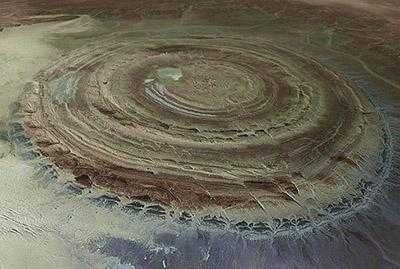
While scientists haven’t settled down to this theory, they still have many questions to uncover concerning the structure. Two Canadian scientists have devised a hypothesis on how the scientists might have established it.
They suggested that the formation could have started more than 100 million years ago when the supercontinent Pangaea broke apart due to plate tectonics. South America and Africa have been ripped apart from each other.
They said that the melted rock that drove upwards toward the earth’s exterior probably didn’t make it, and this could have developed rock coatings in a roof that depicted a massively grown pimple on the shell.
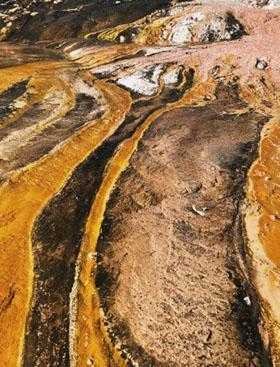
This may have created an error line that surrounded and crossed the structure, which may have broken down then and caused the formation of a rock called Breccia.
Soon after 100 million years, the eye of the Sahara Desert would have vented aggressively. The bubble might have collapsed partially, while corrosion would have done the remaining work and concocted the Sahara’s eye.
The eye loop would have been developed from rocks of various kinds that wear away quickly and vary in time.
When the astronauts found the eye, Sahara has nothing more to share than its sea of sands. They have been very much interested in it ever since.
The eye is only one among a few stops in the sand, ending the monotonic nature. This is why the astronauts are so fond of this phenomenon and have become one of the chief attractions.
Richat structure Timings
It does not have a specific opening time and closing time. Generally, people can explore the area while there is daylight.
Suppose you are seeking reliable information regarding a visit to the Richat Structure. In that case, it’s a good idea to ask the local tourism authorities or look up reliable sources before you plan your trip.
How to reach Richat Structure
You can visit the dry and sandy desert where the Eye of the Sahara is located, but it’s not a fancy or luxurious trip.
You need to get a visa for Mauritania. Some people offer airplane rides or hot air balloon trips so you can see the Eye from above. If you have a strong and well-maintained 4×4 Jeep, you can drive from the city of Oudane to the Richat Structure.
However, hiring an experienced driver who knows the way to the Richat Structure is recommended. Here is the Richat Structure map.
Richat Structure Ticket Price
The Richat Structure is a natural geological rather than a developed tourist site. It is not managed or owned by any specific organization or entity that would charge an entry fee or guide fee.
Even if there may not be a formal admission charge for the Richat Structure, it is nevertheless important for visitors to exercise caution and acquire the relevant authorizations or advice.
This could entail signing up for scheduled excursions or hiring knowledgeable local guides to guarantee a secure and knowledgeable exploration of the region.
5 famous places near Richat Structure
Even though the Richat Structure is a fascinating natural phenomenon, there are a number of other noteworthy Mauritania tourist destinations that are conveniently located nearby. Here are some recommendations:
- Terjit
- Ben Amera
- Chinguetti Mosque
- Banc d’Arguin National Park
- Diawling National Park
Terjit
Terjit is a beautiful place in Mauritania that tourists like to visit. It is an oasis, which means it has water in the middle of the desert. Terjit is located 45 kilometers away from Atar and is popular among visitors.
It is situated in a gorge on the western side of the Adrar plateau. A spring releases water, and right beside it, there is a palm grove that extends for several hundred meters.
Terjit is part of the Maaden commune in the Aoujeft Department. To go inside Terjit, visitors have to pay a small fee. Tourists can also choose to stay in tents in the palm grove.
Many people like to visit Terjit because it is charming, has fresh water, and provides shade from the hot desert sun. It is a place that is used a lot for tourism because of these reasons.
Ben Amera
Ben Amera is the biggest rock in Africa, and it reaches a height of 633 meters (2027 feet) above the ground in the desert. After Uluru in Australia, Ben Amera is the second-largest rock in the world. Ben Amera can be found in Mauritania, near the border with Western Sahara.
It is about 4 kilometers north of a train track where the famous Iron Ore Train passes between Nouâdibhou and Choûm. Many adventurers and nature lovers visit Ben Amera because they want to see its incredible beauty with their own eyes.
Chinguetti Mosque
The Chinguetti Mosque, located in Chinguetti, Adrar Region, Mauritania, is a place of worship with significant historical and religious value. Constructed by the founders of the oasis city of Chinguetti between the thirteenth and fourteenth centuries, this mosque carries deep cultural and religious significance.
It boasts an ancient heritage and is renowned for having the second-oldest minaret still in use among Muslim communities worldwide. The Chinguetti Mosque holds immense respect from the local community, symbolizing cultural and religious pride.
It is highly advised that individuals interested in learning more about Mauritania’s Islamic legacy visit this mosque, which provides a unique opportunity to delve into the region’s rich religious traditions and history.
Banc d’Arguin National Park
The Banc d’Arguin National Park is situated on the coast of Mauritania, in West Africa, between Nouakchott and Nouadhibou. The Banc d’Arguin National Park was previously connected to the Tamanrasset River.
This park serves as a unique breeding and migrating bird’s habitat. Many bird species, such as terns, pelicans, and flamingos, have their home in the park. On sandy islands such as Tidra, Niroumi, Nair, Kijji, and Arguim, they construct their nests.
The surrounding waters are abundant in fish and play a crucial role in fishing activities in Western Africa. Additionally, these waters serve as nesting grounds for birds throughout the western region.
The Banc d’Arguin National Park was established in 1976 to safeguard natural resources and important fishing areas.
Fishing is of great economic significance to the country. The park also features geological sites that are scientifically intriguing and visually stunning. People can visit the park for recreational purposes and enjoy its beauty.
Diawling National Park
The Diawling National Park is situated in the southwest region of Mauritania, encompassing the Senegal River Delta. When the rainy season arrives, the park transforms, forming expansive lakes. It is widely recognized for its diverse bird species, with more than 220 identified, including pelicans, black storks, and flamingos.
The park is also renowned for its flourishing fish population. Established in 1991, the Diawling National Park spans a vast area of 16,000 hectares, previously a floodplain.
Acting as a natural boundary, the Senegal River separates the park from the Djoudj National Bird Sanctuary, established in 1971.
Activities to do near Richat Structure
The Richat Structure, famously called the Eye of the Sahara, is a remarkable geological formation in Mauritania’s Sahara Desert.
Although the immediate vicinity of the structure is predominantly an uninhabited and remote desert area, there are various activities available for visitors in the vicinity:
- Scenic Exploration: Explore the captivating Richat Structure by hiking or driving along its perimeter, marveling at its distinctive circular shape and geological features. Perfect for photography enthusiasts.
- Desert Camping: Experience the tranquility of the surrounding desert as you set up camp and enjoy the serene night sky away from city lights. Remember to come well-prepared with camping gear due to the remote location.
- Desert Treks: Embark on thrilling desert treks or camel rides to discover the vast Sahara Desert surrounding the Richat Structure. Guided tours offer insights into local flora, fauna, and nomadic cultures.
- Stargazing: Witness the breathtaking beauty of the night sky at the Richat Structure, thanks to minimal light pollution. Marvel at constellations, shooting stars, and the mesmerizing Milky Way.
- Cultural Encounters: Engage with nearby towns and villages to immerse yourself in Mauritanian culture and traditions. Engage with the local community, discover their customs, and embrace their hospitality.
Given the remote location and challenging desert conditions, it is advisable to plan visits to the Richat Structure with the assistance of local guides or tour operators who possess in-depth knowledge of the area.
5 Best Hotels To Book Near Richat Structure
Richat Structure Address
Situated in the Sahara Desert, near the town of Ouadane in the Adrar region of Mauritania, lies the awe-inspiring Richat Structure, also known as the Eye of the Sahara. As a remarkable natural geological formation, it lacks a specific street address.
However, you can locate it at approximately 21.098°N latitude and 11.374°W longitude. For a secure and enlightening visit to the Richat Structure, it is advisable to enlist the assistance of a knowledgeable local guide or join a reputable tour group familiar with the area.
FAQs
Richat is not man-made; while its concentric rings and symmetrical shape may give the impression of a man-made structure, it is, in fact, a naturally occurring feature created by erosion and other geologic processes over millions of years.
Some people think the Richat Structure in Mauritania might be Atlantis. It’s a big, old structure that’s been worn down over time, sitting on top of a buried volcanic rock.
The Richat Structure is a big rock formation in Mauritania’s desert. It looks like a crater, but it was made by a volcano and got worn down over time. Now, we can see the layers of rock like an onion.
The Richat Structure has lots of old tools from a long time ago. Ancient people made them called the Acheulean. The tools were found in the low parts around the structure, and some even older tools were found there too.
At first, scientists thought the Eye of the Sahara, also called the Richat Structure, was a huge hole from a crash. But after looking at the rocks in the middle, they found it’s really old, from between 1 billion and 542 million years ago.
These are some famous restaurants near this structure:
1. Le Maquis Restaurant
2. Timeless
3. BEST ‘HOUSE
4. SMASH FOOD
5. Agadir
Read also

